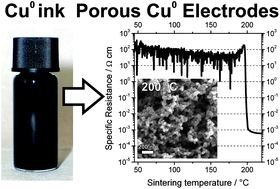Easy access to Cu0nanoparticles and porous copper electrodes with high oxidation stability and high conductivity†
Abstract
Cu0

* Corresponding authors
a
Institut für Anorganische Chemie, Karlsruhe Institute of Technology (KIT), Engesserstraße 15, Karlsruhe, Germany
E-mail:
claus.feldmann@kit.edu
Fax: +49-721-60844892
Tel: +49-721-60842855
b Institut für Werkstoffe der Elektrotechnik, Karlsruhe Institute of Technology (KIT), Adenauerring 20b, Karlsruhe, Germany
Cu0

 Please wait while we load your content...
Something went wrong. Try again?
Please wait while we load your content...
Something went wrong. Try again?
C. Kind, A. Weber and C. Feldmann, J. Mater. Chem., 2012, 22, 987 DOI: 10.1039/C1JM12779A
To request permission to reproduce material from this article, please go to the Copyright Clearance Center request page.
If you are an author contributing to an RSC publication, you do not need to request permission provided correct acknowledgement is given.
If you are the author of this article, you do not need to request permission to reproduce figures and diagrams provided correct acknowledgement is given. If you want to reproduce the whole article in a third-party publication (excluding your thesis/dissertation for which permission is not required) please go to the Copyright Clearance Center request page.
Read more about how to correctly acknowledge RSC content.
 Fetching data from CrossRef.
Fetching data from CrossRef.
This may take some time to load.
Loading related content
